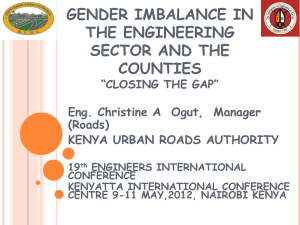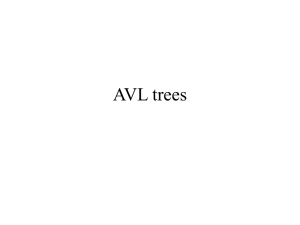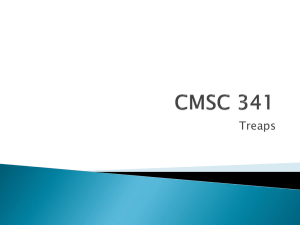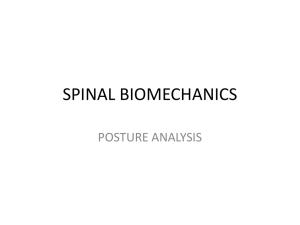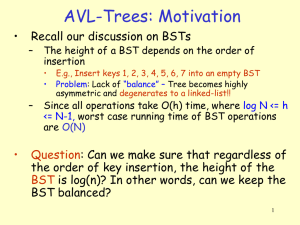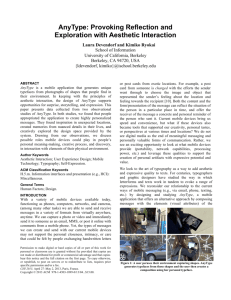AVL tree
advertisement
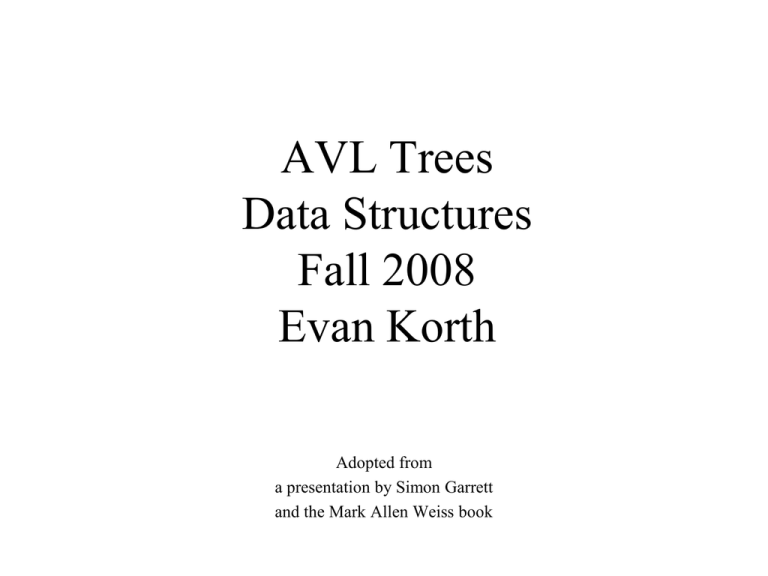
AVL Trees
Data Structures
Fall 2008
Evan Korth
Adopted from
a presentation by Simon Garrett
and the Mark Allen Weiss book
AVL (Adelson-Velskii and Landis) tree
• A balanced binary search tree where the
height of the two subtrees (children) of a
node differs by at most one. Look-up,
insertion, and deletion are O( log n), where
n is the number of nodes in the tree.
• http://www.cs.jhu.edu/~goodrich/dsa/trees/a
vltree.html
Source: nist.gov
Definition of height (reminder)
• Height: the length of the longest path from a
node to a leaf.
– All leaves have a height of 0
– An empty tree has a height of –1
The insertion problem
• Unless keys appear in just the right order,
imbalance will occur
• It can be shown that there are only two
possible types of imbalance (see next slide):
– Left-left (or right-right) imbalance
– Left-right (or right-left) imbalance
– The right-hand imbalances are the same, by
symmetry
The two types of imbalance
• Left-left (right-right)
2
• Left-right (right-left)
Left imbalance
so-called
‘dog-leg’
1
2
1
C
A
B
C
A
B
There are no other possibilities for the left (or right) subtree
Localising the problem
Two principles:
• Imbalance will only occur on the path from the
inserted node to the root (only these nodes have
had their subtrees altered - local problem)
• Rebalancing should occur at the deepest
unbalanced node (local solution too)
Left(left) imbalance (1)
[and right(right) imbalance, by symmetry]
• B and C have the same • Note the levels
2
height
• A is one level higher
1
• Therefore make 1 the
new root, 2 its right
child and B and C the
C
subtrees of 2
A
B
Left(left) imbalance (2)
[and right(right) imbalance, by symmetry]
• B and C have the same
height
• A is one level higher
• Therefore make 1 the new
root, 2 its right child and
B and C the subtrees of 2
• Result: a more balanced
and legal AVL tree
• Note the levels
1
2
A
B
C
Single rotation
1
2
2
1
C
A
B
A
B
C
Left(right) imbalance (1)
[and right(left) imbalance by symmetry]
• Can’t use the left-left
balance trick - because
now it’s the middle
subtree, i.e. B, that’s
too deep.
• Instead consider
what’s inside B...
3
1
C
A
B
Left(right) imbalance (2)
[and right(left) imbalance by symmetry]
• B will have two
subtrees containing at
least one item (just
added)
• We do not know
which is too deep - set
them both to 0.5 levels
below subtree A
3
1
2
C
A
B1 B2
Left(right) imbalance (3)
[and right(left) imbalance by symmetry]
• Neither 1 nor 3
worked as root node
so make 2 the root
• Rearrange the subtrees
in the correct order
• No matter how deep
B1 or B2 (+/- 0.5
levels) we get a legal
AVL tree again
2
1
3
A B1
B2 C
double rotation
2
3
1
1
3
A B1
B2 C
2
C
A
B1 B2
private AvlNode<Anytype> insert(Anytype x, AvlNode<Anytype> t )
{
/*1*/ if( t == null )
t = new AvlNode<Anytype>( x, null, null );
/*2*/ else if( x.compareTo( t.element ) < 0 )
{
t.left = insert( x, t.left );
if( height( t.left ) - height( t.right ) == 2 )
if( x.compareTo( t.left.element ) < 0 )
t = rotateWithLeftChild( t );
else
t = doubleWithLeftChild( t );
}
/*3*/ else if( x.compareTo( t.element ) > 0 )
{
t.right = insert( x, t.right );
if( height( t.right ) - height( t.left ) == 2 )
if( x.compareTo( t.right.element ) > 0 )
t = rotateWithRightChild( t );
else
t = doubleWithRightChild( t );
}
/*4*/ else
; // Duplicate; do nothing
t.height = max( height( t.left ), height( t.right ) ) + 1;
return t;
}
insert
method
rotateWithLeftChild method
private static AvlNode<Anytype> rotateWithLeftChild(
AvlNode<Anytype> k2 )
{
AvlNode<Anytype> k1 = k2.left;
k2.left = k1.right;
k1.right = k2;
k2.height = max( height( k2.left ), height( k2.right ) ) + 1;
k1.height = max( height( k1.left ), k2.height ) + 1;
return k1;
}
rotateWithRightChild method
private static AvlNode<Anytype> rotateWithRightChild(
AvlNode<Anytype> k1 )
{
AvlNode<Anytype> k2 = k1.right;
k1.right = k2.left;
k2.left = k1;
k1.height = max( height( k1.left ), height( k1.right ) ) + 1;
k2.height = max( height( k2.right ), k1.height ) + 1;
return k2;
}
doubleWithLeftChild method
private static AvlNode<Anytype>
doubleWithLeftChild( AvlNode<Anytype>
k3 )
{
k3.left = rotateWithRightChild( k3.left );
return rotateWithLeftChild( k3 );
}
doubleWithRightChild method
private static AvlNode<Anytype>
doubleWithRightChild(
AvlNode<Anytype> k1 )
{
k1.right = rotateWithLeftChild( k1.right );
return rotateWithRightChild( k1 );
}
